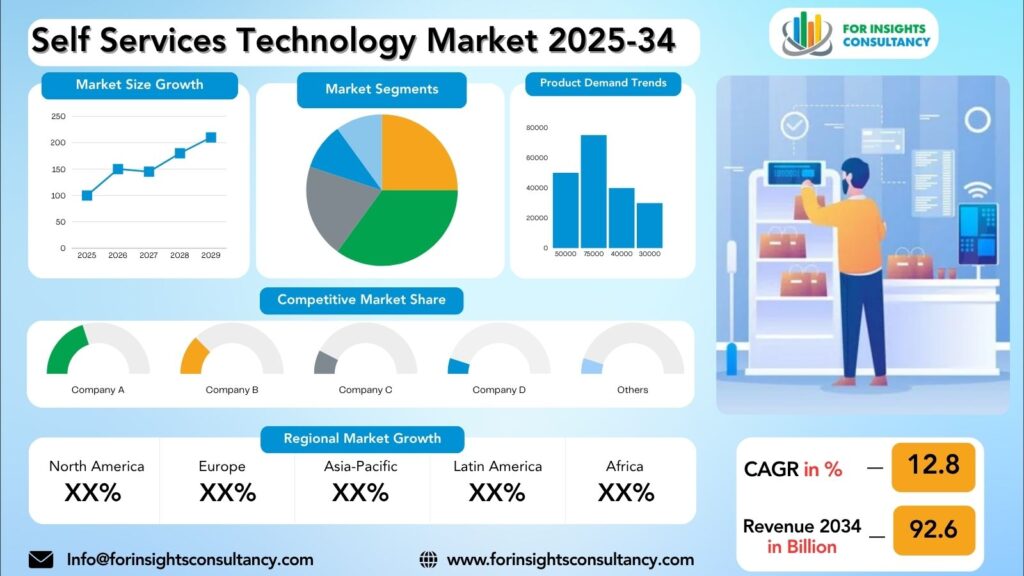
Self Services Technology Market Size, Trends Analysis Research Report by industry (ATMs (Automated Teller Machines), Self-Service Kiosks, Vending Machines, Self-Checkout Systems, Ticketing Kiosks, Information Kiosks, Interactive Digital Signage, Smart Lockers / Parcel Lockers, Banking Self-Service Terminals, Retail Self-Service Solutions, Food & Beverage Ordering Kiosks), and By Region Global Market Analysis And Forecast, 2025-2034
Oct-2025 Formats | PDF | Category: IT | Delivery: 24 to 72 Hours
Self Services Technology Market Is Forecast to Increase from USD 42.9 Billion In 2025 To USD 92.6 Billion By 2034, At A CAGR Of 12.8%.
Self Services Technology Market: A Comprehensive Overview and Future Developments
The market for self-service technology is seeing a rapid increase in growth and new ideas, with a detailed review of different areas such as kiosks, vending machines, ATMs, and interactive displays. These technologies are changing the way that businesses operate and the way they engage with their customers, offering ease and speed. The future changes in this market are certain, with the introduction of AI, IoT, and biometric authentication systems to bring a complete change in the sector. As these technologies continue to develop, the opportunity for delivering better customer experiences, lowering costs, and increasing revenues is very big. Organizations that put money into self-service technology will probably be the ones that are far ahead of the competition and can satisfy the market that is expanding.
Market Dynamics
Trends
Increased Adoption of Interactive Kiosks: As businesses strive to enhance customer experience, interactive kiosks are becoming more popular in various industries.
Integration of AI and Machine Learning: Self-service technologies are increasingly incorporating artificial intelligence and machine learning algorithms to personalize user experiences and streamline processes.
Growth in Contactless Payment Options: With the rise of digital payments, self-service technology market is witnessing a surge in contactless payment options, improving convenience and security.
Expansion of Mobile Self-Service Solutions: Mobile self-service applications are gaining traction, allowing users to access services on their smartphones, leading to increased customer engagement.
Emphasis on Data Security and Privacy: Data security concerns are shaping the self-service technology market trends, with a focus on implementing robust security measures to protect sensitive user information.
Growth Drivers
One of the main reasons for the massive growth in the self-service technology market is the need for self-service kiosks in various sectors due to the COVID-19 pandemic, which has changed user behavior notably.
Besides, the continuous improvement in Artificial Intelligence and Machine Learning is also playing a great role in making the overall customer experience better as more and more self-service solutions are equipped with these technologies.
Furthermore, businesses focusing more on cost-saving and operational efficiency have become a big reason behind such technology’s acceptance in the market as companies are using it to simplify their work flows.
On top of that, the surge in e-commerce and online shopping has also created a demand for self-service options, for instance, automated parcel pickup and self-checkout systems which cater to such growth.
Finally, the rise of the smart city movement is also contributing exponentially to the self-service technology market’s expansion as cities aim to deploy more technology in public transport, parking, and information dissemination to make them more accessible to locals and tourists alike.
Restraints
Security Concerns: One of the main issues of security self-service technologies in times of increasing cyber threats is the security of the concerned companies.
Maintenance Costs: The exorbitant expenses related to the maintenance and repair of self-service kiosks and machines can not only affect the budgets of organizations but can also lead to the shrinking of them.
User Resistance: The users who resist change might be so fond of the traditional service methods that they choose not to use self-service options, which in turn leads to adoption rates going down and usage remaining at a minimum.
Regulatory Compliance: The changes that come with the regulations and compliance requirements can be obstacles to the development and deployment of self-service technologies.
Technological Obsolescence: The rapid development of the technology sector may result in that the self-service solutions become outdated faster than expected and thus the need for frequent upgrading and investing in them.
Integration Challenges: The process of integrating self-service technologies into the already present systems and workflows could be both difficult and lengthy, thereby leading to the poor performance of the concerned operations.
Opportunities
Increasing Demand for Contactless Solutions: The need for technologies that support contactless interactions is continuously increasing as hygiene and convenience are more emphasized.
Integration of AI and Machine Learning: The deployment of artificial intelligence and machine learning algorithms in self-service technology is envisaged to provide a better user experience and facilitate faster operations.
Expansion in Retail and Hospitality Sectors: The retail and hospitality industries will likely expand their self-service technology usage, which could be great news for vendors who have the opportunity to let the industries benefit from their customized solutions.
Focus on Data Security and Privacy: The concerns of data security and privacy that will be addressed by the self-service technology providers will be the main reasons for consumers’ trust and for compliance with the regulations.
Rise of Smart Kiosks and Interactive Displays: The use of smart kiosks and interactive displays will balloon, providing users with tailored experiences and drawing them in through innovative techniques.
Challenges
Integration Complexity: The diversity of self-service technologies has gone to such a degree that the complexity of different systems and platforms integration is a main challenge that businesses face.
Security Concerns: The trend of adopting self-service technologies is going up, however, the security risks are also increasing in the form of data breaches and cyber-attacks, thus keeping security at the forefront of the organization’s concerns.
Consumer Acceptance: Even though self-service technologies might be more convenient and efficient, there is still a fraction of consumers who may opt for the classic way of communication which means a struggle to have the technology widely embraced.
Technological Limitations: The pace of technology growing may become a problem for the businesses who cannot keep up with the latest inventions and have to worry about their self-service solution losing its standing in the market.
Self Services Technology Market Top Companies Covered In This Report:
Evaluate The Strategic Positioning And Innovation Pipelines Of Leading Market Companies-From Multinational Enterprises To Disruptive Regional Firms. Understand How Key Players Are Innovating, Expanding, And Capturing Value, And Use Competitive Benchmarks To Plan Your Next Move.
- KIOSK Information Systems.
- HESS Cash Systems
- AZKOYEN, S.A.
- NatWest Group
- Gulf Bank
- HYOSUNG TNS
- Crane Company
- Toshiba Tec Corporation.
- Fastcorp Vending LLC
Self Services Technology Market Company News 2024 and 2025
Azkoyen, S.A.
Reorganized its structure: created a new wholly‑owned subsidiary called Azkoyen Vending & Payment Solutions (VPS) to handle all industrial & part of the commercial operations (machines and payment systems), separating from its security‑oriented Time & Security division.
HESS Cash Systems
Appointed Harald Heinz as a new Managing Director, jointly with Dominik Seel, to steer the company toward growth in digitization and international markets; also showcased its “Scorpion 411” multifunction casino/redemption terminal at the Slot Summit.
Gulf Bank (Kuwait) partnered with NCR Atleos to enhance its network of ATMs and Interactive Teller Machines (ITMs) to deliver more self‑service banking features.
NatWest Group expanded its self-service banking infrastructure, replacing ATMs and multifunction devices with newer tech via NCR Atleos to modernize its digital‑banking offerings.
Segmented View of The Industry:
The Self Services Technology Market Is Mapped Through A Multidimensional Lens-Tracking Shifts Across Product Type, Applications, And Geographic Regions. This Segmented Approach Enables Businesses to Localize Their Growth Plans And Align Offerings With The Most Profitable Demand Centres.
Segmentation By hardware vs software/services
- ATMs (Automated Teller Machines)
- Self-Service Kiosks
- Vending Machines
- Self-Checkout Systems
- Ticketing Kiosks
- Information Kiosks
- Interactive Digital Signage
- Smart Lockers / Parcel Lockers
- Banking Self-Service Terminals
- Retail Self-Service Solutions
- Food & Beverage Ordering Kiosks
- Healthcare Self-Service Terminals
- Hotel Self Check-in/Check-out Systems
- Parking Payment Kiosks
- Airport Self-Service Systems (Check-in, Baggage Drop)
Global Geographic Coverage:
The Report Provides In-Depth Qualitative And Quantitative Data On The Self Services Technology Market For All Of The Regions And Countries Listed Below:
North America
The self-services technology market of North America is going from strength to strength, supported by an expected GDP growth of 2.5% and low inflation rates. In the United States and Canada areas, the main factor leading to the growth of the market is the rising trend of contactless payment methods that result in a culture of convenience and efficiency.
It is a trend that can be observed very clearly in Canada, where the digital transformation subsidy provided by the government has turned the adoption of self-service kiosks much faster. Online platforms are the leading channel for self-services technology in North America, with e-commerce being the fastest-growing segment due to its convenience and accessibility.
The consumers in these markets are Sustainability and ethical sourcing issues are among their top concerns, which is why businesses have to take these aspects into consideration when trying to attract them. However, in developing markets, where price and status are the main concerns, localism is not as important as affordability and brand recognition.
Europe
Europe’s Self Service Technology Market has been on an upward trend and is expected to have a GDP growth rate of 2.5%, with an average inflation rate of 1.8%. The main local driver in Spain that is affecting the market is the government subsidy for digital transformation projects, which has facilitated the implementation of self-service technologies in different sectors. The region’s leading channel is online platforms, while the fastest-growing channel is mobile applications resulting from their users’ convenience and accessibility.
The consumer in western European countries such as France and Germany consider sustainability and ethical sourcing as important features that the products must-have in these markets. Whereas in the emerging markets of Eastern Europe, price and status are the key factors that influence consumer behavior. Grasping these regional differences is a must-have skill for thriving in the varied European self-service technology market.
Asia Pacific
Asia Pacific and the sub-regions of the Self-Service Technology Market are expected to have strong advancement over the next few years, supported by a bright GDP growth rate and inflation levels considered to be under control. The main driver that is the cause of the trend for self-service technology adoption in Japan is the government’s promotion of cashless transactions, which, as a result, is pushing the market to expand vigorously.
Mobile apps represent the most influential channel for self-service technology in South Korea, whereas the self-service kiosks are the channels with the highest pace of expansion.
Consumers in Australia are focusing on the environment and the origin of the materials used to make the products when buying self-service technology, which, therefore, becomes an essential feature in such products.
Moreover, in developing countries like Indonesia and Thailand, the factors of price and status are still the most influential in consumers’ preferences, which means that market players have the chance to take advantage of these trends.
Middle East and Africa
The Self-Services Technology Market in the Middle East and Africa continues to expand with considerable momentum, mainly due to the region’s estimated GDP growth of 3.9% and an average inflation rate of 5.2%. Besides, the Middle-East and Africa sub-regions are each characterized by a different driver that uniquely affects the market; for instance, the government subsidies for technological advancements in the UAE are the most significant factors leading to a rise in the adoption of self-service kiosks. The leading or dominant channel for self-service technology in the region is online platforms, whereas the quickest growing channel is mobile-based applications owing to the increasing smartphone penetration rates.
Consumers in the Middle East and Africa that choose sustainability as a top priority in their purchasing decisions make ethical sourcing and localism essential factors that can lead to success in the market. Nevertheless, in several emerging markets of the region, price and status are still the main factors that influence consumers’ behavior, which creates a considerable opportunity for market players to devise pricing strategies that can be competitive.
Frequently Asking Questions
What is the Self Services Technology market size and growth forecast?
Self Services Technology Market Is Projected to Reach USD 92.6 Billion by 2034, Growing from USD 42.9 Billion In 2025, At A CAGR Of 12.8% During The Forecast Period.
Who are the key players in the Self Services Technology market?
The Self Services Technology Market Includes Major Companies KIOSK Information Systems., HESS Cash Systems, AZKOYEN, S.A., NatWest Group, Gulf Bank, HYOSUNG TNS, Crane Company, Toshiba Tec Corporation., Fastcorp Vending LLC, Others.
What are the current and future trends for Self Services Technology market?
Current trends: Growing deployment of AI‑driven automation, contactless and biometric interfaces; cloud/hybrid platforms and mobile integration enhancing user convenience and lowering operating costs. Future trends: Increasing personalization via predictive analytics, expansion into verticals like healthcare & hospitality, and rising demand for sustainable, secure, and omnichannel self‑service solutions.
Which regions dominate the Self Services Technology market?
North America dominates the self-service technology market due to advanced infrastructure, high consumer adoption, and strong retail and banking sectors. Asia-Pacific is the fastest-growing region, driven by urbanization, digital transformation, and rising demand in countries like China, India, and Japan.
What are the challenges facing the Self Services Technology market?
High upfront costs, frequent maintenance & technical reliability issues make implementation expensive and risky for many businesses.
Valuable Points from Self Services Technology Market Research Report 2025-2034
- Significant changes in Market dynamics.
- Reporting and assessment of recent industry developments.
- A complete background analysis, which includes a valuation of the parental Self Services Technology Market.
- Current, Historical, and projected size of the Self Services Technology Market from the viewpoint of both value and volume.
- Self Services Technology Market segmentation according to Top Regions.
- Self Services Technology Market shares and strategies of key Manufacturers.
- Emerging Specific segments and regions for Self Services Technology Market.
- An objective valuation of the trajectory of the Market.
- Recommendations to Top Companies for reinforcement of their foothold in the market.
Customized Report as per your Business Needs
- Our analysts will work directly with you and understand your needs
- Get data on specified regions or segments, competitor and Vendors
- Data will be formatted and presented as per your requirements
Any Requirement Contact Us: Https://Www.Forinsightsconsultancy.Com/Contact-Us/
Table of Contents
For TOC Contact us: https://forinsightsconsultancy.com/contact-us/







